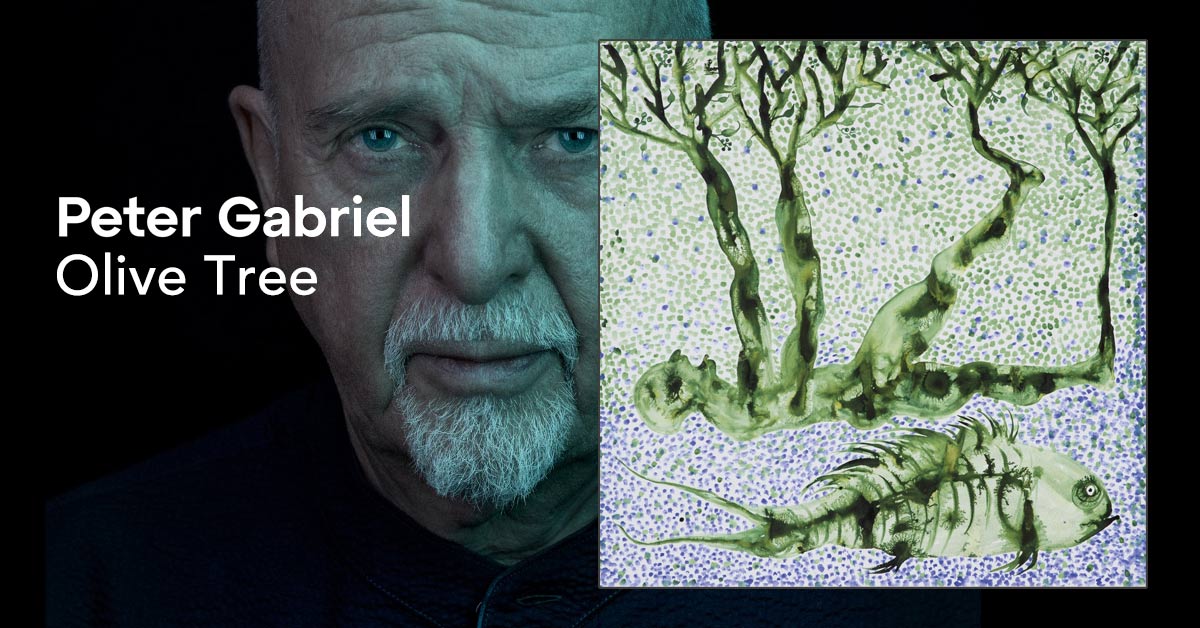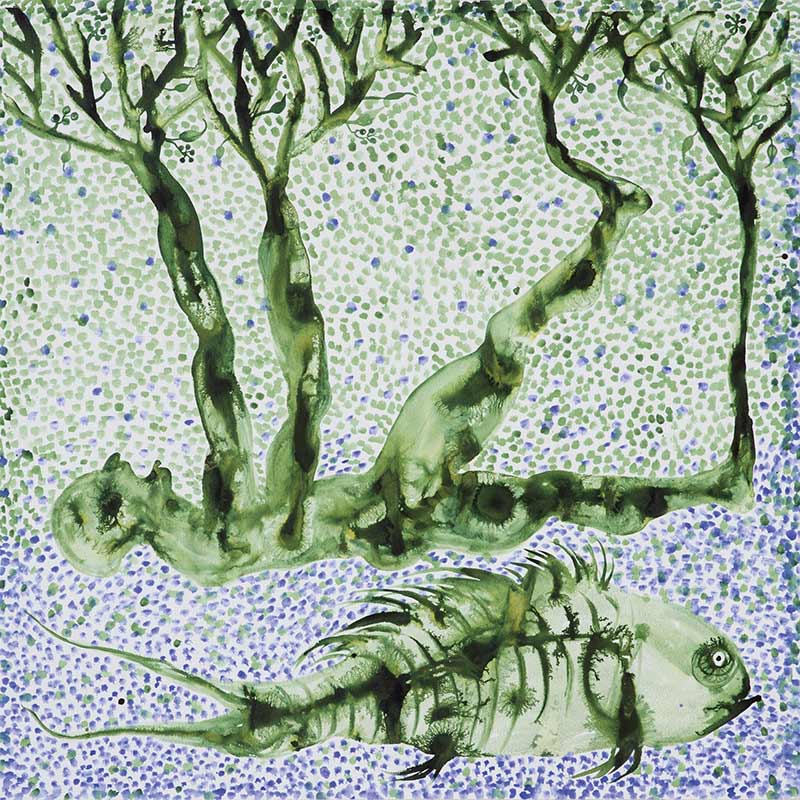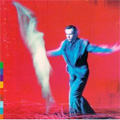


The release cycle in August will be special, because this month has two full moons in 2023. Therefore, two new i/o tracks will be released - although the four-week rhythm will of course remain the same.
Vital and full of life is the first one. Olive Tree tells of someone feeling connected to nature. Who enters other worlds. Who gets in touch with other kinds of life.
During the tour, Gabriel announced the song by explaining that it will soon be possible to convert thoughts of the brain into video images. This can be done with the help of an electrode helmet that detects brain activity. Private things can then become accessible and readable. What may be a frightening thought for many, Gabriel sees from a positive perspective: we will then no longer be lonely islands, but open and connected.
"Unless we get more comfortable with how we really are, we're probably going to prefer to stay partly buried in our private worlds." This promotes thinking in binary terms, dividing into good and bad, rather than seeing everything as part of a whole. It promotes people to judge about others (to echo yet another i/o song).
So in Olive Tree now the journey of one in the world of thought. Specifically, into the world of nature, of plants, of water, of life.
The olive tree, by the way, is generally regarded as a symbol of wisdom and immortality, of permanence and peace.
The sequence of verse, pre-chorus and long main chorus is repeated twice - followed by an intermediate part and finally a textually modified final chorus.
It begins with a look at the ground, with reflections on what lives there and how unstoppably it does so. In the pre-refrain, it is stated that one has been without any connection to all this. But then also: "For the melting of the solid world the change is coming fast".
And then, in the chorus, life bursts forth: The water falling on you is felt, which awakens - as does the connection to everything. "We're all here, just the same, trying to make some sense of it".
In the second verse, the setting is moved to another world, into the water: "And I slide into the waves" - note the double meaning in the context of the song. The helmet is now specifically mentioned, with which thought forms can be made recognisable. Which makes one understand that there were no connection to all the life, to the place "from which we'd grown".
The solemn middle section turns even more decisively towards the water. It "falls on me", breaks the world up and is "pouring from the head". This finally leads to the changed last chorus, in which the ignition of life is finally proclaimed and the water is praised again, becaus it lets grow and become. In the concert, there was a visualisation of Gabriel spraying digitally into drops.
The term "olive tree" does not appear in the entire lyrics.
All lyrics of the album can be found on Peter Gabriel's website here.

The image for the track this time is called Chroniques Avec La Nature and was created by the Cameroonian painter and installation artist Barthélémy Toguo (*1967) explicitly for the song. It is an ink painting
on canvas and based on a loose series of large-format pictures with vital, organic motifs in strong blue.
Toguo's theme is travel, migration, crossing borders, blurring boundaries. And here, as in the song, the boundaries are blurred between man and plant, world and water.
Barthélémy Toguo is considered one of the outstanding artists of the African scene, was artist in residence at WOMAD in 2015, was named a UNESCO Artist for Peace, lives and works both in Paris, France and in Bandjoun, Cameroon.
More about the album artworks and the artists behind them here.
No, this is not a simple pop song - even if Olive Tree comes along in the Bright-Side Mix with the appearance of one. The song grooves bouncy - and seems less energetic than the live version would suggest.
Again an intro - but this time kept short and immediately in the groove of the whole song: the bass drum pulls through the basic beat, a bass pulsates lively, the guitar lays a loose lick over it. Immediately, an African feeling arises. This remains the basis of the whole song.
In the first verse, however, this all is reduced a little, becomes more tentative. Gabriel's singing comes in an intricate melody, one could almost call it atonal. His voice sounds restrained. The accompaniment follows the basic structure, but doesn't use the higher registers any more. The main part remains with Rhodes' guitar.
With the pre-chorus, a noticeable change in harmony gets announced. Gabriel's vocal melody smoothes out. The guitar simplifies itself into simple, lying chords. It feels like a charming creeping up.
Which then breaks into the chorus. The harmony changes, a full backing band enters, along with powerful horns that dominate. It sounds jubilant, full of enthusiasm. The arrangement is enriched with string and synth figures, suddenly giving itself the appearance of a pleasing pop song. - But that's just a trick: this chorus has a lot of lyrics, the vocal melody remains expansive, the mood reflected. It's not really suitable for singing along. But it sounds like it.
In the short transition, hard drum fills appear, which remain through the second verse. The structure also becomes denser in other respects. Towards the next chorus, the proportion of strings grows more and more.
Then for the middle section the arrangement is reduced and thinned out, the focus is on the piano (which had not been there until then), the strings still play lively figures at first. But before it all fades out, the chorus starts again. With different lyrics, with full power and accompaniment. This is joined by deep, whirring electro sounds that were also present in the intro.
In the middle of the climax, the piece breaks off effectively with a final "Water falling on me".
The fact that the song has been in the works for a while is noticeable on the one hand by the fact that Richard Chappell is involved in the drum programming. In the meantime, he has strangely disappeared (also during the tour).
On the other hand, Ged Lynch, who was in the studio for a few days in 2020 (he came also earlier in 2016), is working on the percussion. Up to now, nothing could be heard of his contributions in the i/o tracks, but here he appears.
Josh Shpak plays trumpet and Evan Smith saxophone. These are all the wind players mentioned, although it sounds like more. But that is also due to the string section in John Metcalfe's arrangement that appears again and brings fullness in many places.
It is amazing that the two mixers always manage to wring their own facets out of the songs. Tchad Blake once again makes Olive Tree seem noticeably different. At the same time, he presents a typical Dark-Side Mix, in which many elements have been removed or at least reduced and the arrangement seems more focussed.
It is interesting that in Blake's version, the individual sections of the song are much more clearly distinguished from each other. The Bright-Side Mix is more consistent. And it is noticeable that the Dark-Side Mix is less groovy and bouncy in large parts. In effect, it has more heaviness again.
At first, the intro and the first verse hardly seem any different than in the previous mix. Where there is not much, not much can be varied. The room sound is again a little drier, the bass once again more accentuated, and it remains simple at first.
In the pre-chorus, however, the light drums are mixed back. On the one hand, this keeps the accompaniment in a more restrained position, and on the other, it takes away some of the African feeling of the song. More perceptible, however, is Levin's lively bass.
Then, for the main chorus, the full ensemble suddenly kicks in - creating the same jubilation as in the Bright-Side Mix. But apart from the fact that some accompanying flourishes have been removed, the addition of strong drum beats stands out here. They are a dominant element in the chorus and give the Dark-Side Mix a noticeable uniqueness. They may have come from Ged Lynch, whose additions also take on much greater importance in the short transition and then in the second verse.
In the second pre-chorus, strings become perceptible in the lower registers. They are actually already known from the Bright-Side Mix, but there they are only a part of the overall arrangement - here they are moved more clearly into the centre, become a means in their own right.
The bridge focuses on the rolling snare drum and again the deep string lines. Other elements (such as the piano) are more secondary. The track continues in this way: less detail in the accompaniment, more emphasis on those that are there.
Surprisingly at the very end: the last line "Water falling on me" is missing here. The song ends with the final accent of the strings.
The Bright- and Dark-Side Mixes of Olive Tree already give an idea that Hans-Martin Buff was able to draw from the full range for a Dolby Atmos version and that there were plenty of possibilities to play with the different sounds, instruments and voices.
So it's not surprising that the atmospheric keyboard sounds are already buzzing around in the sound picture in the intro - but without being overused. The bass is very full and crisp in the intro and over the whole song. Drums, percussion and guitar are equally crystal clear.
Listening with Apple Air Pods Pro, as with the other In-Side Mixes, interesting impressions arise when you move your head while listening. The guitar seems to follow the head movements more, the drums and percussion elements stay in place. With the beginning of the verse, Peter's voice is then also arranged in the sound picture in such a way that it stays in one position.
Especially the percussive sounds stand out compared to the other two mixes. Individual beats alternate in the verse on the left and right side. The rhythmic accents in the short vocal break after the line "I can feel it come alive" are also distributed in such a way that they seem to come from different directions. Individual percussions were either used much more prominently in the In-Side Mix or not at all in the other two mixes.
In the chorus it is noticeable that the orchestral part sounds much fuller and more multi-faceted than in the other versions. The wind instruments can be heard, but are given a different role through the use of the strings. They have a different effect due to the overall arrangement and, moreover, are not mixed quite so superficially. In the further course of the song, individual string sections and also the guitar seem to change their position in the sound picture.
Overall, it is noticeable that Hans-Martin Buff has succeeded in creating a very transparent mix despite the abundance of sounds and instruments. While listening, you can hear all details and elements. The sound is warm due to the bass and at the same time crystal clear in connection with the vocals and the other instruments.
The additional version of Olive Tree is entitled "Band Session". We already had this at Panopticom and it must be distinguished from the "Post Band Versions", of which there were some, too.
The Post Band Versions seem to represent stages that also come from the time after the band recordings, but have already additions of further elements. On Road To Joy, for example, the contributions of Don E and Josh Shpak.
The Band Session Versions actually make the cut with the core band recording. - Which is not to say that we only hear Katché, Levin and Rhodes. Before the studio dates, Gabriel had already worked extensively on the songs and in some cases had material recorded by others. Here, for example, percussion by Ged Lynch. They are also included as an additional sound track during the band recording.
On the whole, this is a completely calmed down version of Olive Tree - the basic beat feels halved, even though it's not. Everything just makes a rather decelerated impression.
So here in the intro, only an unobtrusive bass and light rimbeats of the drums prepare the carpet, supplemented by a guitar repeating a calm motif, largely plucked on one side.
However: Already in the intro, light, playful percussion interjections can be heard. Other accompanying elements like keyboards or drum programming are still missing. Everything is handmade, warm and relaxed.
This doesn't change during the first verse and the pre-chorus. Only in the main chorus do light keyboard join in and programmed rhythm additions far in the background. The drums get a little more pressure and the chorus picks up speed here as well - although much less strongly than in the final mixes.
Another interesting thing: from the first pre-chorus onwards, two vocal recordings can occasionally be heard on top of each other. One is probably from the demo recordings that Gabriel sang over during the session. This makes a somewhat bumpy, unfinished impression - but this all is of course an intermediate stage.
Until the next chorus, it goes back to the serenity of the beginning. More space is given to the additional percussion.
The construction of the bridge is more or less the same as in the final versions, but the withdrawal of all accompaniment is not as noticeable here. However, the piano is introduced again here and moved to the centre.
The following chorus is not a shortened version like in the main mixes, but is played through completely. It leads into the beginning of the bridge again, but then makes prematurely a turn and opens the field for the band for a jam for about one minute. Gabriel says: "I always extend the end as very often the band relax when they get to the end of the song and then suddenly the playing becomes something else, so if you've got some groove for them to do their thing then you can have a lot of fun with it."
And really, they're all shuffling around on the basis of the chorus, if that also sets limits. Rhodes gets to repeat two surfy-sounding notes over and over (actually, already from the final chorus onwards). As a new percussive element, powerful handclaps are added, which drive the final part once again until it ends in a final "Oh" exclamation.
And that too: As the first of the provisional versions of i/o, this one is still slightly different in the lyrics: In the first pre-chorus, Gabriel sings instead of "No light reached my eye > I was blind in the eye" - and also the line with the "fungi" does not appear in this way.
And also this: Interestingly, the credits on the Bandcamp page state 18 July as the release date for this version. Another hint that there were still postponements of the songs?



Remastered, contains rare "Silver Song" with Phil Collins on Vocals.
Review available


Peter Gabriel created a mixture of the World Music in Passion with the Mainstream of So.
Review Available